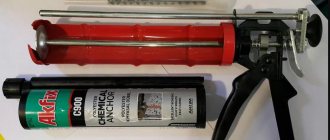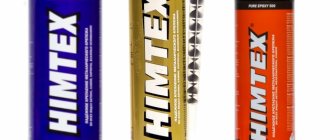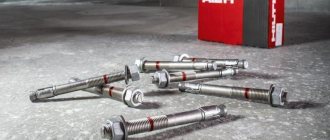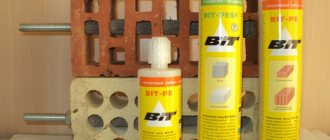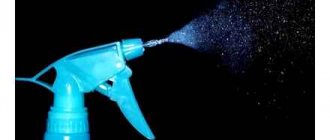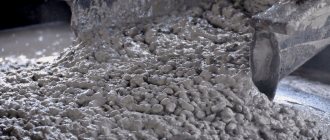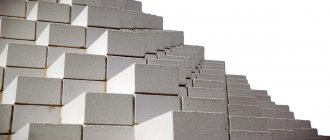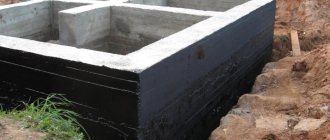What is a chemical anchor?
Chemical anchor (liquid anchor, liquid dowel, adhesive anchor) is a two-component adhesive composition based on synthetic resins, which is a high-tech adhesive system. Externally, it is a tube of glue, in addition to which you need to purchase a special gun for a chemical anchor.
Chemical anchor gun
Initially, the new product was used mainly in the mining industry for the installation of structures and their fastening to loose rocks. Now anchors are successfully used in all areas of construction.
Important! The main difference between liquid anchors and traditional spacer elements is that chemicals provide a higher degree of fixation on fragile, unstable, and complex-structured materials.
Reliability of fastening is achieved through the inclusion of special components in the anchors - synthetic resins based on polyurethane, acrylic, polyester, epoxy oligomers. The exact proportions and names of the components are a trade secret of each manufacturer.
Approximate composition of chemical anchors, in addition to resins:
- fine-grained quartz sand;
- cement;
- hardener, etc.
Types of liquid anchors
There are three main types of chemical fasteners used in construction.
- Injectable. The most versatile and popular, applicable in all types of work;
- Ampoule. Used for small fastenings with the ability to ensure maximum drilling accuracy. They do not require monitoring the degree of filling, but are not applicable for all structures;
- Anchors for reinforcement. Such chemical fastenings are used exclusively by professionals for gluing reinforcement into concrete structures and have specific uses.
Thus, chemical anchors have a great advantage over classic anchor bolts and other fasteners due to their high strength and increased resistance to loads. If used correctly, this mount will last for many years without any deformation.
Operating principle
Liquid anchor is quite easy to use. First, a hole is made in a concrete, brick or other surface, into which the adhesive mass is injected using a gun, and then a metal element is inserted - a rod, a pin, a corrugated reinforcing rod.
As a result, the chemical composition envelops the metal, filling even the smallest gaps between the turns of the thread and the pores of the base. The resins then harden, forming a dense monolith that securely holds the metal part inside the structure. The anchor connection can withstand the highest loads and in this respect is superior to conventional types of fasteners.
Scope of application
A chemical anchor is most suitable for aerated concrete, stone, concrete, and brick (including hollow brick), although it can be used when working with a wide variety of materials.
Important! The use of anchors is especially important in situations where traditional fasteners and dowels cannot ensure a reliable connection. This applies to work with materials such as limestone, expanded clay concrete, cellular concrete, sandstone.
Dowel for aerated concrete
Areas of application of chemical anchor:
- house building – installation of roofing, balconies, building canopies, gazebos, gates;
- fixation of any steel elements;
- installation of handrails in tunnels and other work requiring electrical insulation;
- installation of ventilation systems on weak foundations;
- fastening of large-sized structures;
- arrangement of various underwater structures;
- installation of lifts at ski resorts, advertising elements, scaffolding;
- strengthening the foundation of buildings, connecting to the foundation;
- replacement of reinforcement in critical structures - bridges, stairs, ceilings, support columns, overpasses;
- installation of auxiliary equipment - plumbing, satellite dishes, lights.
Installation of metal structures
The metal fastener itself, suitable for working with a chemical anchor, can be made of stainless steel, carbon or galvanized steel. The composition can be used in conditions of any humidity, including under water.
Himanker for aerated concrete
The porosity of aerated concrete blocks used for the construction of building walls ranges from 40 to 85%. This material is not suitable for attaching heavy hanging structures, furniture elements, suspended ceilings, cabinets to it using nails, dowels or expansion anchors. It uses a chemical anchor for aerated concrete.
Types of fastening depending on the adhesive composition:
- In addition to strong, reliable fixation, epoxy-acrylic adhesive is fire-resistant, frost-resistant, and has a hardening time of 15 to 180 minutes.
- Polyester or polyester reagent is used at room temperature, curing time is from 25 minutes.
- Based on vinylester resin. The reagent is safe for metal, does not cause corrosion, is used in conditions of high humidity, hardening time is up to 24 hours.
- Epoxy adhesive is used when working with all types of concrete. Used for interior and exterior work, moisture-resistant, non-corrosive, used when using smooth fittings and studs without threads.
Types of anchors
Chemical anchors for concrete and other materials are sold in two forms: ampoules and cartridges.
Ampoule
Such anchors are produced for screws of a certain diameter. That is, each fastening point needs its own ampoule - a glass capsule with one-component content or two ampoules with an adhesive and a hardener.
The ampoule is inserted into the hole, after which a metal fastener is inserted, which breaks it. The glue flows out and sets, and the glass shards only help to strengthen the bond.
Capsule Type Chemical Anchor
Typically, ampoule anchors are used where particular precision of the joint is important. It is convenient to work with them, because there is no need to monitor the filling of the hole.
Important! This type of glue is not suitable for vertical structures made of cellular material. The composition will flow down before it hardens.
For the same reason, an ampoule chemical anchor is not suitable for bricks with holes: it is only suitable for solid building materials.
Cartridge
Cartridge anchors are also called injection or injection compounds. They are sold in the form of a volumetric cartridge with a pair of compartments that are filled with different compounds (resin and hardener).
Also on sale are products from two cartridges, the mass of which is mixed in a special gun. Most cartridge anchors are universal, but special compounds for concrete are also available.
Cartridge with two components of the composition
To perform fastening work, put a mixing spout on the cartridge, then insert it into the gun and perform all the necessary actions. This type of chemical anchor is suitable for use on hollow materials.
Before filling, a metal sleeve or plastic sleeve is inserted into the drilled hole so that the composition does not fill large voids in the base. The disadvantage of cartridge anchors is the risk of using too much.
Advice! To reduce consumption, mesh bushings are used, which are selected according to the size of the holes.
Materials and equipment
To install a chemical anchor, you must first prepare a piece of reinforcement or threaded rods, a mesh sleeve, a hammer drill, a drill with a pin diameter of 2 millimeters, torque wrenches, and dust removal products. In addition, you will need protective equipment: rubber gloves, safety glasses and a respirator.
How to mount
- The first step is to drill a hole. To do this, you first need to make a mark for the hole, and then make a cut-off on the drill pin or install a depth-limiting plug. This way you won't be mistaken about the depth of the hole.
After this, a hole is drilled and excess dust is removed with a construction vacuum cleaner or a hand blower and a cylindrical brush. In the latter case, this will take several times longer.Attention!
If dust is not removed, the chemical anchor will not adhere to the surface.
- After the debris is removed, you need to fill the hole with a chemical composition.
Using a construction gun, two-component compositions are introduced. The two compounds are mixed in the spout of the device. At the moment of extrusion, the substances are mixed and a homogeneous substance flows from the nose of the gun into the hole. At this stage you will need a mesh sleeve of the required size. Insert it into the spout all the way and squeeze out the substance. On the first press, you need to pull the tool out a little, and on the second press, pull it out some more. Each time you press the gun, move the device further, this will ensure that the cavity is evenly filled.
Pros and cons of chemical anchors
The building composition has many positive characteristics:
- absolute tightness of the attachment point;
- absence of tensile loads, which is especially important for concrete foundations;
- versatility, ability to operate in various areas of construction and repair, suitability for any materials;
- ease of use, no need for special knowledge and skills;
- the highest strength after final hardening - an indicator greater than that of conventional metal anchors and dowels with a sleeve;
- significant load-bearing capacity, tolerance of serious mechanical loads, regardless of the type of base material;
- resistance to chemicals, corrosion, and negative atmospheric factors;
- Possibility of use at high humidity, under water;
- long service life - up to 50 years;
- absence of toxic compounds (not in all formulations), suitability for indoor use;
- approximate equality of the coefficients of thermal expansion of the composition and most building foundations, which reduces the risk of internal stresses during temperature fluctuations.
Advantages of a chemical anchor over a conventional one
The disadvantages of chemical anchors include a rather long time until complete polymerization and readiness to absorb maximum loads. So, at a temperature of about +50 degrees this time will be 5-7 hours, and at ordinary room temperatures it will be much longer.
During the cold season, the curing process may stop altogether. The shelf life of such formulations is limited - it makes no sense to use them 12 months after production, even if the packaging was sealed.
After opening, you will have to use the product in one go, so for the sake of a couple of fastenings it is better to buy ampoule anchors. The price for this type of fastener is quite high, which repels some buyers.
Advantages and disadvantages
The advantages of chemical anchor bolts are:
- wide scope of application - from the construction of large objects to minor repairs of premises and installation of household appliances;
- manufacturability - no labor-intensive preparation of the solution, the use of complex devices, or highly qualified performers are required;
- increasing the load-bearing capacity of the connection by creating an additional contact area and a monolithic section in the structure;
- resistance of fasteners to vibration and shock loads, thermal expansion, and exposure to aggressive environments;
- durability of the material - the polymer composition can retain its properties for 50 years or more;
- large temperature range for work - some manufacturers claim a range of -18°...+40°, where the quality of the mixture will meet the standard;
- versatility in relation to a variety of fasteners - threaded rods, pins, smooth or grooved fittings, bushings and other metal elements;
- absence of expansion during hardening and expansion stress in the connection, which makes it possible to use a chemical anchor close to the edge of the structure;
- non-toxic during operation;
- compatibility with many building materials.
The disadvantages of liquid dowels include:
- higher price than conventional fasteners;
- limited shelf life - no more than 12 months;
- some solutions cannot be used at ambient temperatures below -5°;
- When using cartridge anchors, you need to ensure that the holes are filled to 2/3, which is quite difficult without experience.
The disadvantages of chemical fasteners are offset by its high versatility and reliability of connections.
Selection rules
Before purchasing, it is important to carefully read the instructions for the chemical anchor. Manufacturers always indicate the types of structures and base materials to which this or that composition is suitable.
It is equally important to take into account the temperature conditions when working with the product, permissible loads on the structure, and possible humidity range. In addition, the anchor must meet the conditions of use according to the following indicators:
- types of fastening;
- fastener placement options;
- dimensions of metal rods;
- hole depth;
- curing speed;
- the need for a mesh sleeve.
For cartridge anchors, you will have to additionally buy a special dispenser gun, which is capable of mixing two components of the composition and dispensing them into a special spout. The price of such a product varies from 1300 to 7000 rubles.
Advice! Ampoule guns are cheaper - from 700 rubles, although you can use a regular drill instead.
Instructions for use
Even a beginner can use chemical anchors. The work includes drilling a hole, preparing it and filling it with compound, as well as screwing in metal bolts. Installation of fasteners is carried out at a temperature not lower than -5 degrees, or using special frost-resistant compounds.
Rules for drilling and preparing holes
When making holes for a chemical anchor and rod, you need to remember: the higher the load on the structure, the more accurate and better all work must be done. In any case, the hole diameter is made larger than the stud or reinforcement.
Drilling is carried out with a hammer drill with a drill of the required size. For cone-shaped holes, special drills with an oscillating jig are used; for drilling concrete walls, hollow drills are used.
Drill with oscillating jig
The finished hole is thoroughly cleaned of dust, preferably using air under pressure. It is best to use a carbon dioxide cylinder. If it is not available, a regular rubber bulb will do.
Important! After blowing, be sure to clean the hole with a brush and blow through again so that no dust remains inside - this is a very important condition for reliable adhesion of the composition to the base.
Sequence of work when gluing
The ampoule is installed directly into the hole of the structure, the pin is inserted using an electric drill or manually. In porous or hollow materials, a mesh sleeve is pre-fixed, which will allow the composition to be distributed more evenly.
The cartridges are placed in a gun with a guide spout, which will squeeze out the mass under pressure. If the length of the metal pin is more than 50 cm, it must be installed mechanically - using a special jig. The fasteners are left until completely hardened (the time is always indicated in the instructions).
Main types and areas of use
The liquid fixative is produced in ampoules for single use or tubes designed to make up to 500 connections.
The ampoule device is a cylindrical capsule filled with an adhesive composition, which is inserted into a pre-drilled hole. A pin or reinforcement is screwed into the cavity, and the shell of the chemical anchor is destroyed.
A two-component mixture of resin and hardener, mixed with the threaded protrusions of the metal part, flows out and fills the hole and pores of the base. When the mass hardens, a reliable connection is formed that can withstand high tensile and shear forces.
For liquid anchor in tubes, a construction gun is used, into which a cartridge with a mixture and a mixer attachment is placed. When it rotates, the chemical elements are mixed, and the polymerization reaction begins. The hole is filled with glue and metal fasteners are inserted. After the solution has hardened, the connection is loaded.
The cartridge with the remaining solution can be reused. To do this, screw on a new mixer attachment. The shelf life of chemical anchors for concrete is up to 12 months.
The composition of the concrete mixture includes additives and deoxidizing agents to slow down the corrosion of reinforcement. This glue is usually of a thick consistency and is used in conjunction with smooth rods or pins.
Threaded anchors require greater fluidity and an accelerated hardening time. In these cases, the parts are glued in with a semi-liquid solution.
Injection anchors are widely used in construction and repair work, where the base is made of loose materials - slag and foam blocks, hollow bricks, slotted or cellular concrete, and the load on the fastenings is quite high. This:
- external structures - wall lanterns, fences, metal or reinforced concrete flights of stairs, supports, canopies;
- internal - plumbing equipment, ceiling lamps, storage water heaters, suspended air conditioners.
Liquid anchors are indispensable in the construction of frame buildings, fastening blocks to the supporting system, heavy ceilings, equipment and scaffolding.
Chemical fasteners allow advertising banners, antennas, radio masts, and road billboards to withstand dynamic loads. Resistance to water is a valuable quality when used in underwater and hydraulic structures - swimming pools, dams, sea or river piers, water parks, and sewers.
Old brick walls with many pores and cavities are restored using liquid chemical mixtures for fasteners.
How to prepare the material yourself
To save money, you can make your own chemical anchor based on epoxy resin. The finished composition is perfect for working with porous and dense materials.
The procedure for creating a tool is as follows:
- Combine ED-20 grade epoxy resin with DBP or DEG-1 plasticizer (up to 5-10% of the resin volume), mix well.
- Add gypsum or cement (also about 5-10%), knead until lumps disappear.
- Combine the composition with hardener UP-583 in a ratio of 1:8-1:10, mix again.
- The composition is fully developed within a minimum time.
- For polymerization, leave the chemical anchor for 12-24 hours.
Manufacturers rating
Compositions from different manufacturers are available on the market. At the same time, the chemical anchors described below can boast of proven quality.
"Titanium"
The basis of the Titan EV-I composition is polyester resin. The dried mixture can work at temperatures up to +80 degrees, while complete polymerization at +25 degrees occurs in just 3 minutes. There is a winter version of Titan EV-W anchors on sale, which can be applied even at -18 degrees.
Sormat
The Finnish company Sormat produces anchors in cylinders and ampoules of various sizes, as well as disposable nozzles for their application. The adhesive is made on the basis of polyester resin and is intended for fastening medium-heavy structures.
BIT
This adhesive composition is used even at sub-zero temperatures (down to -18 degrees). Its base is epoxy acrylate resin.
Main characteristics of the material:
- capable of connecting even heavy concrete structures;
- Suitable for underwater use;
- has low viscosity;
- easy to use;
- does not have a pungent odor.
"Moment"
The chemical anchor “Moment Fastener CF-850” is used for fastening concrete, hollow and solid bricks, foam concrete, and holds heavy structures perfectly. It ensures rapid hardening and high reliability of fasteners and does not contain styrene.
Hilti
The composition of this brand, called Adhisive Capsule Anchor, is based on methacrylic and polyurethane resins, hardener and quartz sand, and is available in capsules and cartridges. It is successfully used even in areas of high seismic activity and under water.
Chemical anchors are an excellent solution for organizing quick and high-quality fastenings during the construction of various structures and structures. Despite the high price, this material has many advantages and makes the task easier for the master.
Description
Chemical anchor BIT-EX is a highly effective two-component chemical composition based on a synthetic high molecular weight epoxy resin that does not contain solvents in combination with metal anchor elements (threaded rods, foundation bolts, reinforcing bars, etc.). Chemical anchors BIT-EX are specially designed for the installation of embedded anchor elements of large diameters under high operating loads, as well as fastening periodic profile reinforcement in concrete and reinforced concrete
for the organization of reinforcement outlets during monolithic construction and reconstruction (installation of reinforcement frames in existing buildings and structures, organization of junctions of columns with floors, strengthening of building structures by adding additional connections, installation of consoles when restoring balconies and loggias during reconstruction, in road construction and reconstruction airfields).
The BIT-EX chemical anchor is fundamentally different from other types of chemical anchors in that, as a result of mixing and subsequent curing of the components in equal proportions (1:1), it forms a new high-molecular compound, the so-called. “cross-linked polymer”, which in its physical and mechanical characteristics is superior to all types of compositions for chemical anchors.
The BIT-EX chemical anchor provides the highest load-bearing capacity when fastening periodic profile reinforcement and has a high adhesion coefficient that is 40-50% higher than the load-bearing capacity and strength characteristics of the BIT-EA chemical anchor (epoxy acrylate). Specially designed for use in holes made using diamond drilling rigs and having a ground smooth internal surface. Particularly recommended for use in wet holes, in water-saturated concrete and under water. The increased curing time allows the installation of reinforcement and anchor elements to greater depths.
The absence of shrinkage deformations allows for the installation of large-diameter fittings, as well as embedded parts with large annular gaps. Withstands high operating temperatures, which allows welding of reinforcing bars when organizing reinforcement outlets.
Attention! Welding of reinforcement outlets must be done before applying the load!
Advantages:
- specially designed for use in heavy concrete foundations (precast and monolithic reinforced concrete, concrete blocks)
- Any reinforcing bars, threaded rods, anchor and foundation bolts can be used as an anchor
- allows installation of anchors close to the edge of the structure
- does not create stress in the base material
- it is possible to apply high loads at small distances between the axes of the fastenings and from the edge of the structure
- high operational reliability of fastenings subject to dynamic influences
- color of the composition –
red (to facilitate control of the correct installation of anchors) - dual cartridges 400 ml and 600 ml
- does not contain solvents
- Used in wet holes and under water
- resistance to high temperatures (up to +120°C)
- Ideal for fastening in holes made using diamond core bits
- extended cure time (provides convenience when filling large volumes of holes)
- high performance characteristics when fastening periodic profile reinforcement
- absence of shrinkage deformations - recommended when using reinforcement of large diameters (with large annular gaps)
- extremely high resistance to aggressive environments, acids, alkalis, sea water, petroleum products and oil refinery wastewater
- extended shelf life (determined by the mobility of the chemical composition in the package)
Regulatory and permitting documentation:
- Technical certificate ITB AT-15-6895/2011 (Institute of Construction Technology)
- WRAS certificate (for use in contact with drinking water)
- Technical certificate of the Ministry of Regional Development of the Russian Federation No. 3440-11
- Research of strength and deformability (TsNIISK named after V.A. Kucherenko)
- Frost resistance tests (TsNIISK named after V.A. Kucherenko)
- Certificate of conformity ROSS GB.AYA.46.N64023 (chemical compositions)
- Certificate of conformity ROSS GB.AYA.46.N64113 (anchor elements)
- Certificate of state registration RU.40.01.05.015.E06049.08.12
Curing time and setting time of the chemical composition
| Base temperature (C°) | Setting time1 (minutes) | Curing time2 (minutes) |
| +35 | 12 | 180 |
| +25 | 20 | 300 |
| +15 | 60 | 600 |
| +5 | 120 | 960 |
1 - the anchor is installed in the hole, its position can be adjusted
2 - complete curing of the composition, application of load is possible
ATTENTION! In wet holes, the curing time is doubled.
Geometric characteristics when installing anchors in a base made of heavy concrete B20 (C20/25)
| Anchor diameter, d | Hole diameter d o | Diameter of the hole in the attached structural element, df (mm) | Standard depthcrafts, Lo | Maximum tightening torque Tinst |
| M8 | 10 | 9 | 80 | 10 |
| M10 | 12 | 11 | 90 | 20 |
| M12 | 14 | 13 | 110 | 40 |
| M16 | 18 | 17 | 125 | 80 |
| M20 | 24 | 22 | 170 | 120 |
| M24 | 28 | 26 | 210 | 160 |
| M30 | 35 | 33 | 280 | 200 |
Performance characteristics of anchor fastenings at a standard embedment depth in a base made of heavy concrete B20 (C20/25)
| Anchor diameter, d (mm) | Maximum load* ( kN) | Design load (kN) | Recommended load (kN) | Standard edge distance (mm) | Standard distance between anchor axes, Cbw (mm) | ||||
| To break out (NRk) | Shear (VRk) | To break out (Nc al ) | To cut (Vcal) | Breakout (Nr) | Shear (Vr) | Pull-out (Ca,N) | Per cut (Ca,V) | ||
| M8 | 19,9 | 9,4 | 12,7 | 7,2 | 9,0 | 5,1 | 80 | 80 | 160 |
| M10 | 31,7 | 15,7 | 20,1 | 12,0 | 14,3 | 8,5 | 100 | 90 | 200 |
| M12 | 45,9 | 22,0 | 29,2 | 16,8 | 20,8 | 12,0 | 120 | 110 | 240 |
| M16 | 85,6 | 40,9 | 54,4 | 31,2 | 38,8 | 22,2 | 160 | 175 | 320 |
| M20 | 133,0 | 64,0 | 60,3 | 48,8 | 43,0 | 34,8 | 200 | 225 | 400 |
| M24 | 182,9 | 92,4 | 82,9 | 70,4 | 59,2 | 50,2 | 240 | 280 | 480 |
| M30 | 2940,0 | 149,6 | 186,7 | 114,0 | 133,3 | 81,4 | 300 | 280 | 600 |
* The load-bearing capacity is reduced if the standard distances from the edge/between the axes of the anchors are reduced. The corresponding safety factors must be taken into account (see BIT technical catalogue)
Detailed information about all products, operating conditions and design conditions is contained in the BIT technical catalogue.
Attention! The chemical composition was developed based on its own unique technology and is the “know-how” of BIT United Ltd. All indicators are given only for chemical anchors of the BIT brand. Technical information on strength characteristics, load-bearing capacity and safety factors does not apply to products from other manufacturers.
